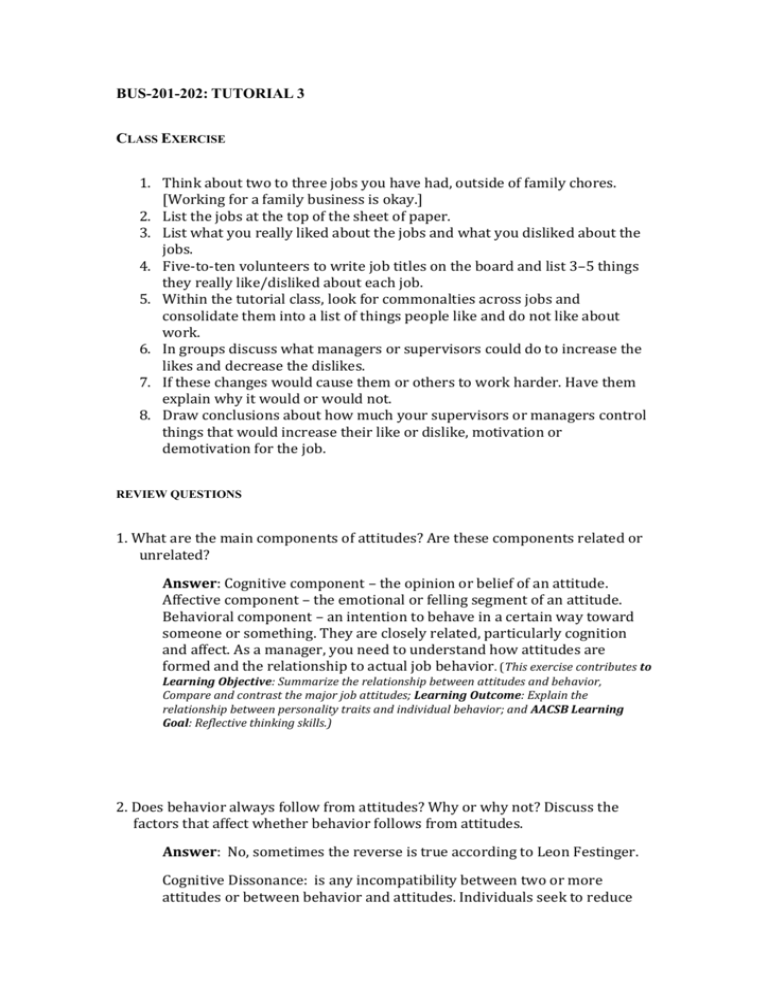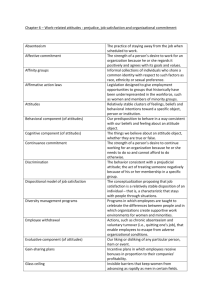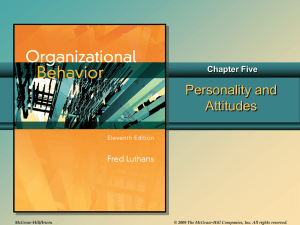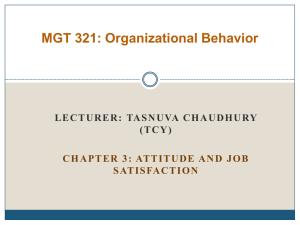BUS-201-202: TUTORIAL 3 Class Exercise Think about two to three
advertisement

BUS-201-202: TUTORIAL 3 CLASS EXERCISE 1. Think about two to three jobs you have had, outside of family chores. [Working for a family business is okay.] 2. List the jobs at the top of the sheet of paper. 3. List what you really liked about the jobs and what you disliked about the jobs. 4. Five-to-ten volunteers to write job titles on the board and list 3–5 things they really like/disliked about each job. 5. Within the tutorial class, look for commonalties across jobs and consolidate them into a list of things people like and do not like about work. 6. In groups discuss what managers or supervisors could do to increase the likes and decrease the dislikes. 7. If these changes would cause them or others to work harder. Have them explain why it would or would not. 8. Draw conclusions about how much your supervisors or managers control things that would increase their like or dislike, motivation or demotivation for the job. REVIEW QUESTIONS 1. What are the main components of attitudes? Are these components related or unrelated? Answer: Cognitive component – the opinion or belief of an attitude. Affective component – the emotional or felling segment of an attitude. Behavioral component – an intention to behave in a certain way toward someone or something. They are closely related, particularly cognition and affect. As a manager, you need to understand how attitudes are formed and the relationship to actual job behavior. (This exercise contributes to Learning Objective: Summarize the relationship between attitudes and behavior, Compare and contrast the major job attitudes; Learning Outcome: Explain the relationship between personality traits and individual behavior; and AACSB Learning Goal: Reflective thinking skills.) 2. Does behavior always follow from attitudes? Why or why not? Discuss the factors that affect whether behavior follows from attitudes. Answer: No, sometimes the reverse is true according to Leon Festinger. Cognitive Dissonance: is any incompatibility between two or more attitudes or between behavior and attitudes. Individuals seek to reduce this uncomfortable gap, or dissonance, to reach stability and consistency. Consistency is achieved by changing the attitudes, modifying the behaviors, or through rationalization. The desire to reduce dissonance depends on: a. Importance of elements b. Degree of individual influence c. Rewards involved in dissonance (This exercise contributes to Learning Objective: Summarize the relationship between attitudes and behavior, Compare and contrast the major job attitudes; Learning Outcome: Explain the relationship between personality traits and individual behavior; and AACSB Learning Goal: Reflective thinking skills.) 3. What are the major job attitudes? In what ways are these attitudes alike? What is unique about each? Answer: Job Satisfaction - A positive feeling about the job resulting from an evaluation of its characteristics. Job Involvement - Degree of psychological identification with the job where perceived performance is important to self-worth. Psychological Empowerment is another closely related concept that is the belief in the degree of influence over the job, competence, job meaningfulness, and autonomy. Organizational Commitment - Identifying with a particular organization and its goals, while wishing to maintain membership in the organization. Organizational commitment has three dimensions: 1. Affective – emotional attachment to organization 2. Continuance Commitment – economic value of staying 3. Normative – moral or ethical obligations Organizational commitment has some relation to performance, especially for new employees. It is less important now than in past – now perhaps there is more of an occupational commitment, or a loyalty to a profession rather than a given employer. There is a positive relationship between organizational commitment and job productivity, however, modest. Evidence suggests that these attitudes are highly-related. Some employees though, seem to be predisposed to be positive or negative about many things. Additional job attitudes include improved organizational support and employee engagement that are work-related attitudes that also need to be understood by managers. Overall, there is some distinction, but a lot of overlap. (This exercise contributes to Learning Objective: Summarize the relationship between attitudes and behavior, Compare and contrast the major job attitudes; Learning Outcome: Explain the relationship between personality traits and individual behavior; and AACSB Learning Goal: Reflective thinking skills.) 4. How do we measure job satisfaction? Answer: Job satisfaction is a positive feeling about a job resulting from an evaluation of its characteristics. There are two widely used approaches to measure job satisfaction. Single global rating (one question/one answer) that is considered the best and summation score (many questions/one average) that is considered okay. (This exercise contributes to Learning Objective: Summarize the relationship between attitudes and behavior, Compare and contrast the major job attitudes; Learning Outcome: Explain the relationship between personality traits and individual behavior; and AACSB Learning Goal: Reflective thinking skills.) 5. What causes job satisfaction? For most people, is pay or the work itself more important? Answer: Pay and personality are the two main factors that seem to influence job satisfaction. Pay influences job satisfaction only to a point. After about $40,000 a year (in the U. S.), there is no relationship between amount of pay and job satisfaction. Money may bring happiness, but not necessarily job satisfaction. Personality can influence job satisfaction. Negative people are usually not satisfied with their jobs. Overall, those with positive core self-evaluation are more satisfied with their jobs. (This exercise contributes to Learning Objective: Summarize the relationship between attitudes and behavior, Compare and contrast the major job attitudes; Learning Outcome: Explain the relationship between personality traits and individual behavior; and AACSB Learning Goal: Reflective thinking skills.) 6. What outcomes do job satisfaction influence? What implications do these have for management? Answer: Job satisfaction influences the following OB issues Satisfaction and Job Performance Job Satisfaction and Organizational Citizenship Behavior (OCB) Job Satisfaction and Customer Satisfaction Job Satisfaction and Absenteeism Job Satisfaction and Turnover Job Satisfaction and Workplace Deviance Implications for management include: Satisfied and committed employees have lower rates of turnover, absenteeism, and withdrawal behaviors. They also perform better on the job. Given that managers want to keep resignations and absences down—especially among their most productive employees—they’ll want to do things that generate positive job attitudes. Managers will also want to measure job attitudes effectively so they can tell how employees are reacting to their work. As one review put it, “A sound measurement of overall job attitude is one of the most useful pieces of information an organization can have about its employees.” The most important thing managers can do to raise employee satisfaction is focus on the intrinsic parts of the job, such as making the work challenging and interesting. Although paying employees poorly will likely not attract highquality employees to the organization or keep high performers, managers should realize that high pay alone is unlikely to create a satisfying work environment. There are a number of ways managers can detect dissatisfaction. They include: (Exhibit 3-5) Exit: Behavior directed toward leaving the organization, including looking for a new position as well as resigning. Voice: Actively and constructively attempting to improve conditions, including suggesting improvements, discussing problems with superiors, and some forms of union activity. Loyalty: Passively but optimistically waiting for conditions to improve, including speaking up for the organization in the face of external criticism, and trusting the organization and its management to “do the right thing.” Neglect: Passively allowing conditions to worsen, including chronic absenteeism or lateness, reduced effort, and increased error rate. Exit and neglect behaviors encompass our performance variables—productivity, absenteeism, and turnover. Voice and loyalty are constructive behaviors allow individuals to tolerate unpleasant situations or to revive satisfactory working conditions. It helps us to understand situations, such as those sometimes found among unionized workers, where low job satisfaction is coupled with low turnover. (This exercise contributes to Learning Objective: Summarize the relationship between attitudes and behavior, Compare and contrast the major job attitudes, Identify four employee responses toe dissatisfaction; Learning Outcome: Explain the relationship between personality traits and individual behavior; and AACSB Learning Goal: Reflective thinking skills.)








